
Eve’s Creation
“God built the rib that He took from the man into a woman; and He brought her to the man.” (Gen. 2:22)
The Midrash adds a curious detail to the Torah’s account of Eve’s creation. When God “built” Eve, He braided her hair before bringing her to Adam. How do we know that God braided her hair? The Midrash brings a linguistic proof: in a certain language, the word for “braid” is binita, similar to the Hebrew word biniya (to build).
This idea that braiding hair is a form of building is not just a quaint notion, but has legal ramifications. The Talmud rules that it is forbidden to braid hair on the Sabbath, since braiding constitutes the melachah of building (Shabbat 95a).
What is the significance of God braiding Eve’s hair? Is braiding hair truly a form of building?
Satisfying the Soul
Generally speaking, there are two objectives when building a structure. The first is utilitarian. We build houses in order to be sheltered and protected from the elements.
But there is often an additional aspect to building: the aesthetic value of a beautiful home. The Sages taught in Berachot 57b that the elegance of a well-designed residence can revive a one’s spirits and “broaden one’s outlook.” An aesthetically-pleasing environment quiets the mind and soothes the heart.
What is so significant about the aesthetic side of building?
What makes humans special and is, in fact, their true strength, is their spiritual side. Our natural desire for beautiful living accommodations indicates that even that which would seem to be purely utilitarian — a structure to satisfy our need for shelter — should nonetheless contain elements of beauty and harmony. One might think that the function of a house is only to protect us from the rain and the cold. But in fact, beautiful surroundings can be inspiring, deepening one’s appreciation for nobler aspirations. It is this innate pursuit of beauty and refined life that will eventually lead all of humanity, after purging the baser aspects of life, to a lofty and elevated state.
We can now better appreciate the Talmudic account of Eve’s formation. The Midrash calls our attention to the fact that the very first “construction” undertaken for the sake of humanity already recognized this fundamental quality of human nature.
Eve’s creation enabled humanity to reproduce, a basic physical function. Even so, her creation was accompanied by the aesthetic act of braiding her hair. Thus we find that even for those biological functions shared with the animals, the human soul demands that they be imbued with beauty.
The act of braiding Eve’s hair established this inner truth: the human soul cannot be satisfied with the utilitarian fulfillment of physical needs. The soul’s spiritual needs must also be addressed, as the practical is combined with a higher, aesthetic component.
(Adapted from Ein Eyah vol. IV, p. 237)
Illustration image: ‘A girl plaiting her hair’ (Ludwik Misky, 1916)





